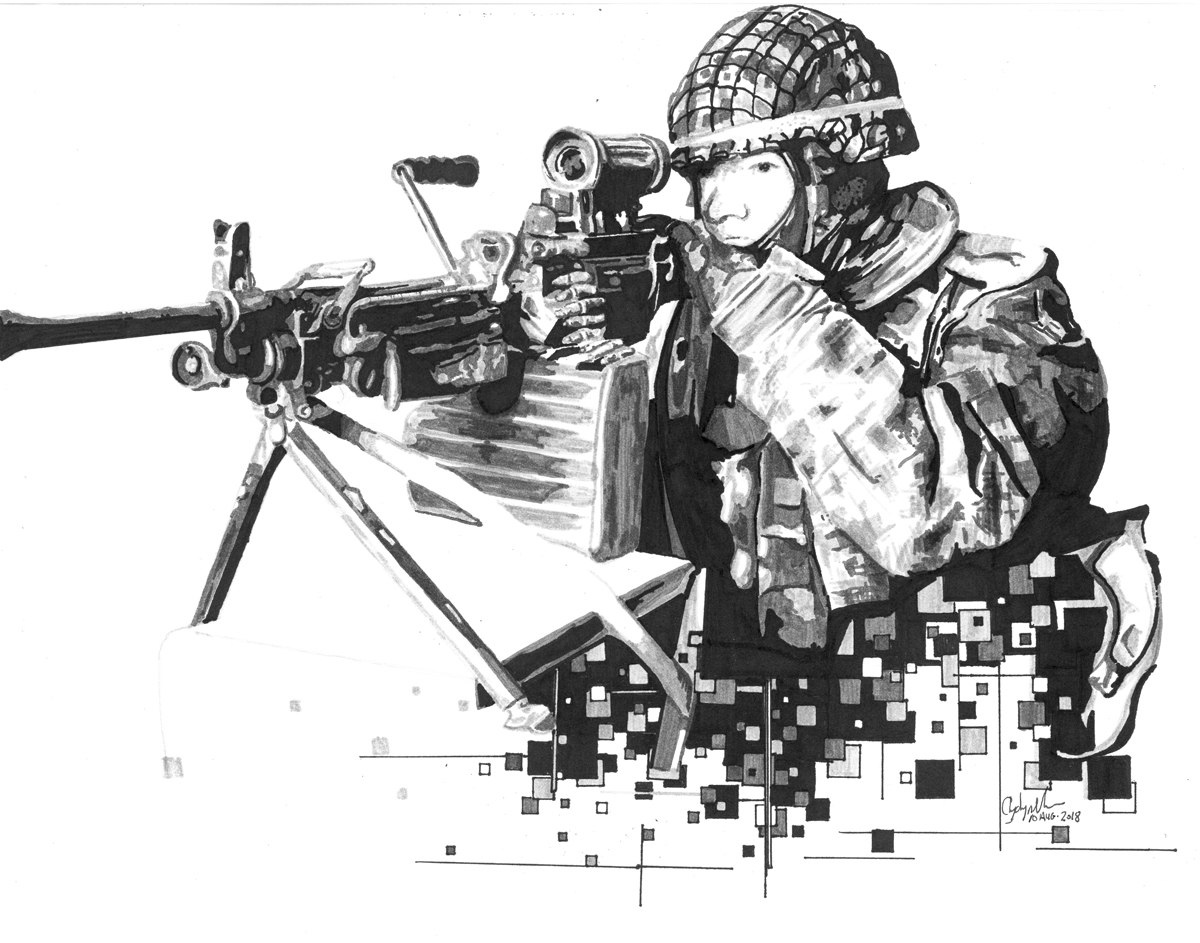COUNTER ATTACK WATCH
A pen and ink self portrait that is based on a photograph taken by my fire team partner while on a defensive exercise in Meaford, ON. I drew this piece to portray a sense of mental exhaustion and sleep deprivation while maintaining a vigilant watch. This period of my career was the most difficult, both mentally and physically. It is also a personal reminder that when things in life seem to not be going well, or times are tough, I think back to this time and remind myself “Well, at least I’m not in Meaford.” – Master Corporal Aydyn Neifer
Peter Mallett
Staff Writer
––
Sketchbook, pencils, eraser, even chalk and pens are some of the first things Master Corporal Aydyn Neifer packs when deployed – even before his camera equipment.
The Canadian Armed Forces Imagery Technician has embraced many art forms in his 43 years, from graphic design to photography, to drawing and painting.
“I can’t imagine not painting,” he says. “It’s a way to express myself even if no one ever sees them. Most of my works are just about painting for the sake of painting and trying to turn abstract concepts into visual art. I can’t imagine not being able to do that.”
Much of his work is inspired by his military service that started in 2007 as a member of Third Battalion, Royal Canadian Regiment in Petawawa, ON. After three years as an Infantryman, he re-mustered to Image Tech, a trade that satisfies his itch to create.
What he likes about the military is it can take him out of his comfort zone.
“The military constantly challenges you to complete difficult tasks and learn new things,” he says.
That constant evolving is duplicated in his art. His craft tools are varied, from the usual acrylic paints, pencils, and inks, to ball point pens and pastels. His subjects are equally assorted.
“I am really not sure what my style of art or genre is called, but I try to take a concept from a photo or series of photos and then visualize it in my creations,” he explains.
His vision starts with an image, usually a photo. In his self portrait Counter Attack Watch, it was a fellow soldier who snapped the photo while they were on a training exercise in Meaford, Ont. It’s a pen and ink side view of a younger Pte Neifer peering intensely down the barrel of his machine gun set against a stark white background. His torso fades into geometric squares. The empty background brings a feeling of bleakness and isolation, something he felt at the time as he battled exhaustion while maintaining a vigilant watch.
In contrast, Cerebral Shackles is a full colour piece of a young person clutching her cellphone, half open eyes on the screen. Swirling around her, soft images of people, things, and words.
The creation, he says, is a deliberate attempt to show the ill-effects that social media addiction and the scourge of fake news has had on so many people.
“The concept is to visually portray how, in essence, we are all addicted and enslaved by our technology,” says MCpl Neifer. “It’s like a cerebral toffee pull for both our attention and our sanity.”
He’s created many pieces over the years from a small studio he made in the basement of his home, which he shares with his wife and three children. A few of his ink drawings and acrylic works are on the walls upstairs, but most have been completed and tucked into boxes.
“I have a stack of practice pieces, and over the years have accumulated many finished works that were completed in different types of media, from oils, to charcoal, to pastel, to acrylics, to graphite, and watercolour, as well as digital. As well, I have a stack of sketchbooks that I have filled up over the years.”
But his prized piece resides on a high school wall, a mural he painted as a student.
“I won a design contest to paint a mural at my high school, Fellowes, in which I helped to paint my design alongside a professional mural painter. The mural is still up in the school.”
He currently works as a photography instructor at Canadian Forces Training and Development Centre at CFB Borden. He is also part of The Steel Spirit, an art collective that showcases the unique artwork of military, police, firefighters, paramedics, hospital practitioners, and other first responders.
Never one to have an empty canvass, MCpl Neifer is working on an art piece for a friend to help bring awareness to brain injury victims.
Art, he adds, brings him much-needed calm in an often intense job.
“In my opinion art is truly a great form of self expression and a vehicle to externalize injuries. My art is more preventative medicine.”
––––
